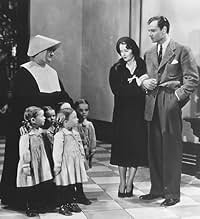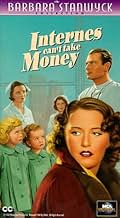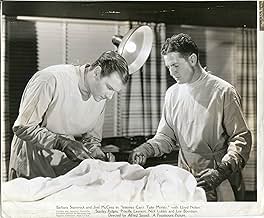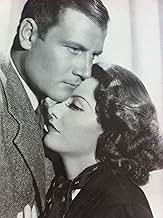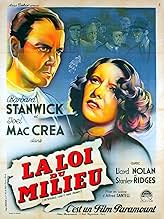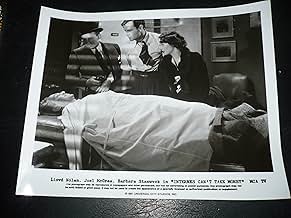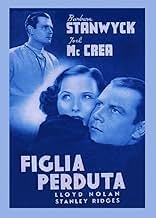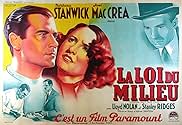IMDb-BEWERTUNG
6,8/10
874
IHRE BEWERTUNG
Füge eine Handlung in deiner Sprache hinzuIn his first film, young Dr. Kildare helps a female ex-con find her child.In his first film, young Dr. Kildare helps a female ex-con find her child.In his first film, young Dr. Kildare helps a female ex-con find her child.
- Regie
- Drehbuch
- Hauptbesetzung
- Auszeichnungen
- 1 wins total
Steve Pendleton
- Interne Jones
- (as Gaylord Pendleton)
James Adamson
- Porter
- (Nicht genannt)
Agostino Borgato
- Popcorn Vendor
- (Nicht genannt)
Helen Brown
- Nurse
- (Nicht genannt)
Empfohlene Bewertungen
Probably not, but it has a certain cachet to it that is reminiscent of the genre that was yet to come. Good folk and gangsters, an unsuspecting someone caught in a web of dishonesty and murder, and all with the shadows and photographic effects normally associated with film noir. It is also an early Dr. Kildare film with Joel McCrea as the good doctor.
Nutshell: Kildare comes across Barbara Stanwyck, who is destitute and desperate. She is looking for her lost child and she is broke and just released from prison, apparently framed for aiding and abetting her husband. Kildare tries to help, with the aid of a gangster (Lloyd Nolan) on whom he has done emergency surgery (in the back of a barroom!) and who now feels he owes Kildare a favor.
The cast is excellent, headed by Stanwyck who never gives a bad performance. McCrea is his usual understated self and Stanley Ridges is very effective as a seedy, slimy villain. This is a very underrated film and was shown at Capitolfest, Rome, NY, 8/19.
******** 8/10 - Website no longer prints my star rating.
Nutshell: Kildare comes across Barbara Stanwyck, who is destitute and desperate. She is looking for her lost child and she is broke and just released from prison, apparently framed for aiding and abetting her husband. Kildare tries to help, with the aid of a gangster (Lloyd Nolan) on whom he has done emergency surgery (in the back of a barroom!) and who now feels he owes Kildare a favor.
The cast is excellent, headed by Stanwyck who never gives a bad performance. McCrea is his usual understated self and Stanley Ridges is very effective as a seedy, slimy villain. This is a very underrated film and was shown at Capitolfest, Rome, NY, 8/19.
******** 8/10 - Website no longer prints my star rating.
INTERNES CAN'T TAKE MONEY (Paramount, 1937), directed by Alfred Santell, is a medical drama based on the story by Max Brand, creator of the Doctor Kildare character. It also is the movie that introduces Doctor Kildare to the screen. Though many film historians believe Lew Ayres to be the original Doctor Kildare of the movies, it is an unknown fact that this first Kildare of the screen was actually played by Joel McCrea. With no Doctor Gillespie (Lionel Barrymore in the Ayres series) as his supervisor and mentor, nor setting at Blair General Hospital as depicted in the Metro-Goldwyn-Mayer series (1938-1942), this introduction to the noteworthy character is less hospital melodrama combining sentimentality and crime drama using two separate stories for two basic characters.
Following camera tracking to various medical rooms where young interns in clinics are taking care of patients and their needs, Jimmie Kildare (Joel McCrea) is introduced as a young interne at Mounview General Hospital making $10 a month treating a second degree burn on left forearm wrist of Janice Haley (Barbara Stanwyck), who later faints of malnutrition. Later that evening, Doctor Howard J. Pearson (Pierre Watkin), hospital superintendent, gathers his staff together for the dismissal of Interne Weeks (Lee Bowman), a friend of Kildare's, for experimental liver operation on a patient who has died. While comforting Weeks at the nearby bar, Janice enters to meet with Dan Innes (Stanley Ridges), a gangster. It is revealed that Janice is a widow of Jim Haley, bank robber who had taken her 11 month baby and hidden her someplace. Having served a two year prison term for not revealing information about her husband's criminal activities, Janice, now paroled, comes to the racketeer hoping for information regarding the whereabouts of her now three-year-old daughter. Innes agrees to help her for $1,000, which she does not have. In the meantime, Kildare encounters Hanlon (Lloyd Nolan), a racketeer who enters the bar only to keel over due to severe knife wound. Kildare secretly takes the injured gangster to the back room of the bar and off the record does an immediate operation to save his life. Later, Kildare receives an envelope with $1,000 cash from bartender known as "One Eyed" Jeff (Irving Bacon). When Janice learns Kildare's money she desperately needs to find her child, her attempt to steal the envelope fails. Kildare gives back the money to Hanlon only because the "internes can't take money." Coming to terms with hospital rules, Hanlon agrees to assist Kildare with any favors needed. When Kildare learns of Janice's history, he comes to Hanlon for assistance, at the risk of losing his own medical career if caught. Also in the cast are: Barry Macollum (Stooley Martin); Charles Lane (Grote, the gambler who must earn the money lost to Innes by acting as his butler); Lillian Harmer (Mrs. Mooney, the Landlady); Fay Holden (Mother Theresa) and Gaylord Pendleton (Interne Jones).
Being the only "Doctor Kildare" movie produced by Paramount and featuring Joel McCrea, this is a good introduction to the Max Brand character. It also marks the third of six screen collaborations of Stanwyck and McCrea, with INTERNES CAN'T TAKE MONEY being one of their most underrated. Though Kildare is still the central character, the premise focuses more on the Stanwyck character, giving a standout performance and given extreme facial close-ups with realistic teary-eyedbuildup scenes that work with conviction. Stanwyck is most believable in her role of a desperate mother going through extremes searching for her infant child. Heartfelt moments include Stanwyck overlooking little sad looking three-year-old girls in orphanage, hoping one of them would be her very own daughter. Lloyd Nolan and Stanley Ridges give commendable performances as mobsters, with Nolan being more sympathetic through his tough guy image.
Unseen on commercial television since the late 1970s (notably WPIX, Channel 11 in New York City prior to 1973, and some showings on New Jersey's WTVG, Channel 68 (1976-1978), INTERNES CAN'T TAKE MONEY, which has, to date, never been shown in cable TV, did become available in 1995 on video cassette and DVD in 2013. Regardless of crime melodrama, sentiment and medical issues, INTERNES CAN'T TAKE MONEY is worthy screen 77 minute , thanks to its fine casting of actors and direction that rise above average script material. (***)
Following camera tracking to various medical rooms where young interns in clinics are taking care of patients and their needs, Jimmie Kildare (Joel McCrea) is introduced as a young interne at Mounview General Hospital making $10 a month treating a second degree burn on left forearm wrist of Janice Haley (Barbara Stanwyck), who later faints of malnutrition. Later that evening, Doctor Howard J. Pearson (Pierre Watkin), hospital superintendent, gathers his staff together for the dismissal of Interne Weeks (Lee Bowman), a friend of Kildare's, for experimental liver operation on a patient who has died. While comforting Weeks at the nearby bar, Janice enters to meet with Dan Innes (Stanley Ridges), a gangster. It is revealed that Janice is a widow of Jim Haley, bank robber who had taken her 11 month baby and hidden her someplace. Having served a two year prison term for not revealing information about her husband's criminal activities, Janice, now paroled, comes to the racketeer hoping for information regarding the whereabouts of her now three-year-old daughter. Innes agrees to help her for $1,000, which she does not have. In the meantime, Kildare encounters Hanlon (Lloyd Nolan), a racketeer who enters the bar only to keel over due to severe knife wound. Kildare secretly takes the injured gangster to the back room of the bar and off the record does an immediate operation to save his life. Later, Kildare receives an envelope with $1,000 cash from bartender known as "One Eyed" Jeff (Irving Bacon). When Janice learns Kildare's money she desperately needs to find her child, her attempt to steal the envelope fails. Kildare gives back the money to Hanlon only because the "internes can't take money." Coming to terms with hospital rules, Hanlon agrees to assist Kildare with any favors needed. When Kildare learns of Janice's history, he comes to Hanlon for assistance, at the risk of losing his own medical career if caught. Also in the cast are: Barry Macollum (Stooley Martin); Charles Lane (Grote, the gambler who must earn the money lost to Innes by acting as his butler); Lillian Harmer (Mrs. Mooney, the Landlady); Fay Holden (Mother Theresa) and Gaylord Pendleton (Interne Jones).
Being the only "Doctor Kildare" movie produced by Paramount and featuring Joel McCrea, this is a good introduction to the Max Brand character. It also marks the third of six screen collaborations of Stanwyck and McCrea, with INTERNES CAN'T TAKE MONEY being one of their most underrated. Though Kildare is still the central character, the premise focuses more on the Stanwyck character, giving a standout performance and given extreme facial close-ups with realistic teary-eyedbuildup scenes that work with conviction. Stanwyck is most believable in her role of a desperate mother going through extremes searching for her infant child. Heartfelt moments include Stanwyck overlooking little sad looking three-year-old girls in orphanage, hoping one of them would be her very own daughter. Lloyd Nolan and Stanley Ridges give commendable performances as mobsters, with Nolan being more sympathetic through his tough guy image.
Unseen on commercial television since the late 1970s (notably WPIX, Channel 11 in New York City prior to 1973, and some showings on New Jersey's WTVG, Channel 68 (1976-1978), INTERNES CAN'T TAKE MONEY, which has, to date, never been shown in cable TV, did become available in 1995 on video cassette and DVD in 2013. Regardless of crime melodrama, sentiment and medical issues, INTERNES CAN'T TAKE MONEY is worthy screen 77 minute , thanks to its fine casting of actors and direction that rise above average script material. (***)
... except this one is from Paramount and stars Joel McCrea as Dr. James Kildare. Like in the MGM series starting the following year, Dr. Kildare is an intern in a large New York City hospital, he lives on subsistence wages, and has a pretty grueling schedule. Unlike the MGM series there is no hot tempered wheelchair bound mentor in the person of one Dr. Gillespie. In all of his judgements here, Kildare is pretty much on his own.
As an intern in the hospital, Kildare treats a young woman for a burn on her hand (Barbara Stanwyck as Janet Haley). She also turns out to be undernourished so Kildare makes her lie down and drink a glass of milk. He then discharges her. It turns out Janet does have a job, she's just been cutting corners including her own meals to save money to pay for stool pigeons to help her find her own three year old child. She had been stolen by her estranged husband to keep her quiet about his illegal activities, but he died after pulling a hold up before he could tell her where the child was. She spent two years in prison because everybody believed she was in on the robbery with her husband.
If this is starting to sound like it is mainly about Stanwyck's character and not so much about Kildare, you would be right. This is mainly Stanwyck's film. But Kildare does figure heavily into helping Janet solve her dilemma. Also figuring heavily into the plot is Kildare's big taste for risk if it helps somebody out. That includes sewing up a gangster (Lloyd Nolan) after he shows up at a cafe and bar near the hospital, stabbed in some underworld activity and requiring immediate medical attention.
I think I prefer Lew Ayres' interpretation of the role, but this film is still worthwhile.
As an intern in the hospital, Kildare treats a young woman for a burn on her hand (Barbara Stanwyck as Janet Haley). She also turns out to be undernourished so Kildare makes her lie down and drink a glass of milk. He then discharges her. It turns out Janet does have a job, she's just been cutting corners including her own meals to save money to pay for stool pigeons to help her find her own three year old child. She had been stolen by her estranged husband to keep her quiet about his illegal activities, but he died after pulling a hold up before he could tell her where the child was. She spent two years in prison because everybody believed she was in on the robbery with her husband.
If this is starting to sound like it is mainly about Stanwyck's character and not so much about Kildare, you would be right. This is mainly Stanwyck's film. But Kildare does figure heavily into helping Janet solve her dilemma. Also figuring heavily into the plot is Kildare's big taste for risk if it helps somebody out. That includes sewing up a gangster (Lloyd Nolan) after he shows up at a cafe and bar near the hospital, stabbed in some underworld activity and requiring immediate medical attention.
I think I prefer Lew Ayres' interpretation of the role, but this film is still worthwhile.
An exceptionally flavorful rendering of the Depression atmosphere: a world of the poor laboring in sweatshop jobs, petty hoods hanging out in smoky bars, backroom bookie joints, pushcart vendors and bus terminals and orphanages. While the plot is no more ambitious than the typical B movie of the time, the high production values, name cast, and imaginative direction from Alfred Santell all boost the quality.
At the center of the plot, Barbara Stanwyck spends much of the film in desperation mode, exhausted from searching for her lost child, beaten down by two years in jail, forced to hire stool pigeons, forced to stay alert.
Joel McCrea makes the ideal American hero for the 30's: not only a doctor, but tall, blond, honest, sincere, manly, and progressive. At one point, he has to perform an operation on a bar room table, improvising with violin strings, an ice pick, and a bottle of rum! But this is not MGM's Dr. Kildare. He has no warm relationship with a kindly old mentor; instead, the chief doctor is an authority figure upholding the rules, dismissing Lee Bowman for unauthorized experimentation. The script also pumps up sympathy for interns as underpaid workers who get only $10 a month.
As a gangster, the always fascinating Stanley Ridges conveys the calm of a man secure in his power, whose eye movements size up his adversaries and whose silences reveal more menace than mere words. Watch the sexual innuendo he finds in his "I didn't always like popcorn" speech.
Santell uses extreme close-ups and moves the camera often, aided by gleaming lighting from Theodore Sparkuhl, plus some knock-out sets, including a sparkling white Art Deco clinic and an elaborately detailed New York Irish bar. Watch how economically Santell works to show the awakening of mutual attraction between Stanwyck and McCrea in their first scene together. Also lifting the picture out of its formula origins is the headlong pace Santell maintains to the climax, an urgency lost in the blander MGM series.
At the center of the plot, Barbara Stanwyck spends much of the film in desperation mode, exhausted from searching for her lost child, beaten down by two years in jail, forced to hire stool pigeons, forced to stay alert.
Joel McCrea makes the ideal American hero for the 30's: not only a doctor, but tall, blond, honest, sincere, manly, and progressive. At one point, he has to perform an operation on a bar room table, improvising with violin strings, an ice pick, and a bottle of rum! But this is not MGM's Dr. Kildare. He has no warm relationship with a kindly old mentor; instead, the chief doctor is an authority figure upholding the rules, dismissing Lee Bowman for unauthorized experimentation. The script also pumps up sympathy for interns as underpaid workers who get only $10 a month.
As a gangster, the always fascinating Stanley Ridges conveys the calm of a man secure in his power, whose eye movements size up his adversaries and whose silences reveal more menace than mere words. Watch the sexual innuendo he finds in his "I didn't always like popcorn" speech.
Santell uses extreme close-ups and moves the camera often, aided by gleaming lighting from Theodore Sparkuhl, plus some knock-out sets, including a sparkling white Art Deco clinic and an elaborately detailed New York Irish bar. Watch how economically Santell works to show the awakening of mutual attraction between Stanwyck and McCrea in their first scene together. Also lifting the picture out of its formula origins is the headlong pace Santell maintains to the climax, an urgency lost in the blander MGM series.
The first Dr. Kildare film, from Paramount. It has no connection to the later MGM series, of which I'm a big fan. Despite not having many of the elements I enjoy in those movies, this one is still entertaining. Joel McCrea and Barbra Stanwyck have nice chemistry. Lloyd Nolan and Stanley Ridges are great as gangsters, one rotten and one not so much. The best parts of the film are the hospital scenes that give us lots of "window into the past" bits that show us how life was at the time. Particularly how the medical profession was different. The visual style is more enhanced in these scenes, too. The hospital set is also pretty cool. Probably the one thing this film has over the MGM series. Worth a look whether you are a fan of Kildare or not.
Wusstest du schon
- WissenswertesBarbara Stanwyck asked director Al Santell to cast Joel McCrea as her leading man, having worked with him twice before. "I want this guy," she told him. "He's going to be a good leading man."
- PatzerDuring the bar-room conversation (c.16 minutes) the coffee cup on the table disappears, re-appears and moves between shots.
- Zitate
Bookie: Maybe it's the cops.
"Chief" Hanlon: Cops don't knock, they break in.
- VerbindungenFollowed by Dr. Kildare - Sein erster Fall (1938)
Top-Auswahl
Melde dich zum Bewerten an und greife auf die Watchlist für personalisierte Empfehlungen zu.
- How long is Internes Can't Take Money?Powered by Alexa
Details
- Erscheinungsdatum
- Herkunftsland
- Sprache
- Auch bekannt als
- Internes Can't Take Money
- Drehorte
- Manhattan, New York City, New York, USA(Second unit opening credits)
- Produktionsfirma
- Weitere beteiligte Unternehmen bei IMDbPro anzeigen
- Laufzeit
- 1 Std. 18 Min.(78 min)
- Farbe
- Seitenverhältnis
- 1.37 : 1
Zu dieser Seite beitragen
Bearbeitung vorschlagen oder fehlenden Inhalt hinzufügen

